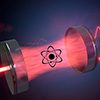| Nov 25, 2025 |
Scientists have developed a new approach to applying thermodynamics to microscopic quantum systems.
(Nanowerk News) In 1798, the officer and physicist Benjamin Thompson (a.k.a. Count Rumford) observed the drilling of cannon barrels in Munich and concluded that heat is not a substance but can be created in unlimited amounts by mechanical friction.
|
|
Rumford determined the amount of heat generated by immersing the cannon barrels in water and measuring how long it took the water to reach boiling. Based on such experiments, thermodynamics was developed in the 19th century. Initially, it was at the service of the Industrial Revolution and explained, physically, for instance, how heat can be efficiently converted into useful work in steam engines.
|
|
Today, the laws of thermodynamics are part of the basic knowledge of all natural scientists: the total energy – the sum of heat and work – in a closed system remains constant, and disorder, or entropy, never decreases.
|
|
These laws are generally valid, but when trying to apply them to the smallest quantum systems, one quickly runs into difficulties. A team of researchers at the University of Basel, led by Professor Patrick Potts, has now found a new way to define thermodynamic quantities consistently for certain quantum systems. Their results were published in the scientific journal Physical Review Letters (“Thermodynamic Framework for Coherently Driven Systems”).
|
 |
| When laser light passes through a cavity filled with atoms, part of it can do useful work (for instance, charge a quantum battery, top), whereas the other part turns into “heat” (bottom). (Image: Enrique Sahagún, Scixel / University of Basel)
|
Laser light in a cavity
|
|
“The problem we have with the thermodynamic description of quantum systems is that in such systems, everything is microscopic. This means that the distinction between work, which is useful macroscopic energy, and heat, or disordered microscopic motion, is no longer straightforward”, doctoral student Aaron Daniel explains.
|
|
By way of an example, Daniel and his colleagues took a closer look at so-called cavity resonators in which incident laser light is reflected back and forth between two mirrors and, eventually, partially exits the cavity.
|
|
Unlike the light from an ordinary light bulb or LED, laser light has the special property that all its electromagnetic waves oscillate exactly in lockstep. However, if the laser light passes through a cavity filled with atoms, this lockstep – also called coherence – can be disturbed to a greater or lesser extent. In this case, the light becomes partially or entirely incoherent (which corresponds to the disordered motion of particles). “The coherence of the light in such a laser-cavity-system was the starting point of our calculations”, says Max Schrauwen, a bachelor’s student involved in the project.
|
Work by coherence
|
|
The researchers first defined what they mean by “work” in the context of laser light: for instance, the capacity to charge a so-called quantum battery. This requires coherent light that can collectively take an ensemble of atoms to an excited state. For the sake of simplicity, one might now assume that the coherent laser light entering the cavity is able to do work, while the partially incoherent laser light exiting the cavity is not. In this view, the light leaving the cavity should be called “heat”.
|
|
However, even partially incoherent light can, in principle, still do some useful work – just less than completely coherent light. Daniel and his colleagues investigated what happens when the coherent part of the exiting light is considered work and only the incoherent part is treated as heat. The result: if work is defined in this way, both laws of thermodynamics are fulfilled and, therefore, the approach is consistent.
|
|
“In the future, we can use our formalism to consider more subtle problems in quantum thermodynamics”, says Daniel. This is relevant, for instance, for applications in quantum technologies such as quantum networks. Furthermore, the transition from classical to quantum behavior of macroscopic systems can be investigated even better in this way.
|


